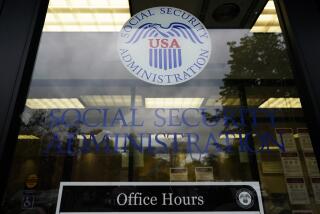Here’s a big tax mistake you can easily avoid

- Share via
Dear Liz: I’m self-employed and my wife wasn’t working last year. In December, we returned to California and found a small home to purchase using $107,000 I took out of my IRA. Since we weren’t quite certain of what our income would be, we received our health insurance in Oregon through an Affordable Care Act exchange.
When we filed our taxes we got hit with a $20,000 bill for the insurance, because we earned too much to qualify for subsidies, and a $10,000 bill for the IRA withdrawal. Our goal was to own our home outright, which we do, but now we have a $30,000 tax bill hanging over us.
Can we work with the IRS somehow on this? We didn’t “earn” the $107,000; we invested it in a home. It wasn’t income, so why should we be punished for using our savings to purchase a home?
Answer: If you mean, “Can I talk the IRS out of following the law?” then the answer is pretty clearly no. The IRA withdrawal was income. It doesn’t matter what you did with it.
Consider that you probably got a tax deduction when you contributed to the IRA, which means you didn’t pay income taxes on that money. The gains have been growing tax deferred, which means you didn’t pay tax on those, either.
Uncle Sam gave you those breaks to encourage you to save for retirement, but he wants to get paid eventually. That’s why IRAs and most other retirement accounts are subject to required minimum distributions and don’t get the step-up in tax basis that other investments typically get when the account owner dies.
(If you did not get a tax deduction on your contributions, by the way, then part of your withdrawal should have been tax-free. If you’d contributed to a Roth IRA, your contributions would not have been deductible but withdrawals in retirement would be tax-free.)
The IRS does offer long-term payment plans that may help. People who owe less than $50,000 can get up to six years to pay their balances off. You would file Form 9465 to request a payment plan. The IRS’ site has details.
Here’s a good rule to follow in the future: If you’re considering taking any money from a retirement account, talk to a tax professional first. People often dramatically underestimate the cost of tapping their 401(k)s and IRAs; a tax pro can set you straight.
Timing those spouse benefits
Dear Liz: My husband and I are retired. He is 67 and I’m 65. We have been delaying Social Security as we are financially able to wait until he turns 70 to begin benefits. We both turned 62 before January 2, 2016, and are wondering how the “restricted application” rule applies to us. My husband was the primary worker and will have a payout at 70 that is more than twice what I will be paid, so I would be the one taking the spousal benefit. Would you recommend we continue to wait until he is 70 to start benefits, or does the rule make it smarter for us to begin sooner?
Answer: Typically when someone applies for Social Security, she is “deemed” to be applying both for her own benefit and for any spousal benefit that might be available. Restricted applications allowed someone to apply only for a spousal benefit, allowing her own benefit to grow, since delaying the start of benefits increases the amount by about 7% to 8% each year. She could switch to her own benefit when it maxed out at age 70.
Congress changed the rules to eliminate restricted applications for people who turn 62 on or after Jan. 2, 2016. Although a restricted application is still available to you, your husband must be receiving benefits before your spousal benefits can begin. (There used to be something called “file and suspend,” that would allow your husband to trigger spousal benefits without receiving his own, but that has been eliminated. He would have had to reach his full retirement age and requested the suspension before April 30, 2016.)
One other detail that’s important: While your husband’s benefit will continue to grow if he doesn’t start until age 70, the spousal benefit will not. The maximum spousal benefit is 50% of your husband’s benefit at his full retirement age, which was 66. The spousal benefit is further reduced if you should start it before your own full retirement age (which is also 66).
In most cases, it’s best for the higher wage-earner to wait as long as possible to begin, which would mean you would start spousal benefits in three years when your husband turns 70. Remember that it’s the larger check one of you will have to live on after the other one dies; you don’t continue to receive two checks, so it’s usually worth trying to max out the larger one. If you file a restricted application for spousal benefits only, you’d have the option of switching to your own benefit at 70 if it’s larger. You may want to use the Social Security claiming calculator at AARP’s site to evaluate your options.
Liz Weston, certified financial planner, is a personal finance columnist for NerdWallet. Questions may be sent to her at 3940 Laurel Canyon, No. 238, Studio City, CA 91604, or by using the “Contact” form at asklizweston.com. Distributed by No More Red Inc.
More to Read
Inside the business of entertainment
The Wide Shot brings you news, analysis and insights on everything from streaming wars to production — and what it all means for the future.
You may occasionally receive promotional content from the Los Angeles Times.










